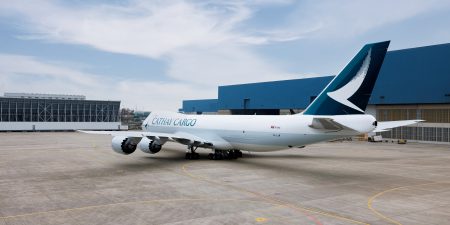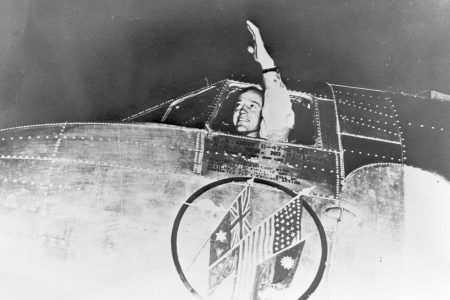You could say the history of the Cathay Cargo is bookended by humps. The first ‘Hump’ was the route over the eastern Himalayas, flown during the Second World War from India to China to restock the US and China’s war effort against Japan. 70 years on, the hump at this end of the company’s story is the ‘bubble’ atop the airline’s current fleet of Boeing 747 freighters.
It’s hard to imagine now, but the historic predecessor to the Boeing 747-8F (Cathay Pacific has 14 of these) was a post-war DC3 converted from its military C47 guise, stuffed to the gunnels with a payload of woollen clothes, toothbrushes and the dreams of the American Roy Farrell.
The Texan, free from his wartime flying responsibilities, bought and flew his DC3 Dakota – Betsy – to Shanghai from New York (above). He and his subsequent airfreight business co-founder, the Australian Syd de Kantzow, had cut their teeth ‘flying the Hump’. This was a hazardous enterprise in terms of cost to men and machines; 594 planes were lost, 1,659 staff killed or missing. Notwithstanding, this was still the greatest airlift on record until exceeded in 1949 by the tonnage moved in the Berlin Airlift.
In his book Over the Hump Brigadier General William Tunner, who was in charge of both operations, recalled: ‘After the Hump, those of us who had developed an expertise in air transportation knew that we could fly anything anywhere anytime.’
That was very much the inspiration behind Farrell’s move from pilot to would-be airline magnate. By the end of the war, he had ‘flown the Hump’ more than 520 times. This and his recognition of the enormous potential for trade in post-war China, especially Shanghai, led him to take the plunge. Having secured Betsy – now on permanent display in Hong Kong’s Science Museum – he was able to secure the necessary paperwork to fly goods from Sydney on a long, multi-stop route to Shanghai. As the fleet of DC3s grew, Farrell became more of the business brain, and skilled flyer de Kantzow took on the operational role of crewing the fledgling fleet and keeping it in the air.




